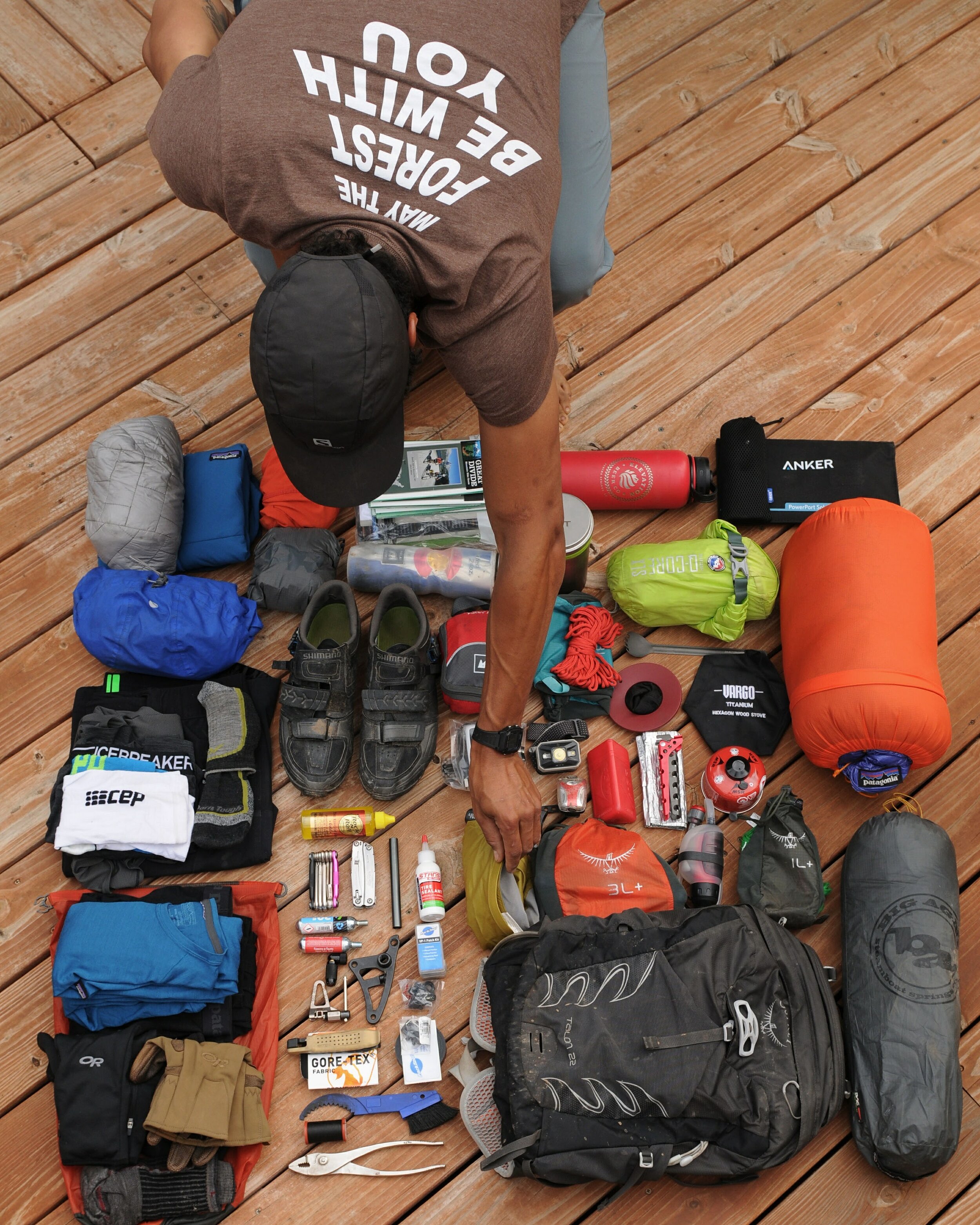In January 2017, I decided to ride the Great Divide Mountain Bike Route (GDMBR) in August of that year. As an outdoor professional and outdoorsman, I wanted to test my skills by cycling down the spine of the Rockies on a self-supported adventure. I spent the year preparing the logistics and assembling my equipment. With no more than a couple of overnight trips under my belt, I arrived in Banff, Alberta, excited and anxious to pedal back home to Colorado, covering about ⅔ of the GDMBR.
By day 1 and 2, I experienced my worst fear - grizzly bears. I’d run into them along the route and gave the deepest, throatiest shout I could muster to protect myself. It worked! With the adventure starting off with much excitement, I set out to travel back into the States. A week into the route I experienced a near-serious injury in both my Achilles heels, which caused me to take a couple of day’s rest in Helena, MT. Departing the mining town, I started cycling with a now great friend, Alan, a 60-year-old (at that time) climber and outdoorsman. Together we experienced the vast and open landscape of the Rocky Mountains.
Some of my favorite places along the route were just outside of Banff, Alberta, and the Great Divide Basin, WY. Once I arrived in Colorado, a tailwind ushered me over some of the most beautiful mountain passes I had seen, right up to my doorstep. Riding the Great Divide left me with an incredible feeling of self-empowerment and accomplishment. I recommend the route to anyone seeking a life-changing adventure.
Planning and Preparing
Below are some of the most important topics to plan and prepare for anyone preparing to bikepack a long-distance route such as the Great Divide. This is no exhaustive list of things to prepare for, rather a shortlist of critical planning items.
Be confident and competent with where you are traveling and where your resupply points are, i.e. food, bike shops, water, alternative routes, etc. Study any needed maps and/or GPX files before departing. Call ahead to make sure resupply points are open, especially in smaller towns.
Have an emergency plan for every point along the route. Whether you have a mechanical or injury, or you need to get back home asap, have a plan for what to do. You can have plans for things such as riding to an alternative destination, having extra bike components, and possibly hitching a ride if need be. A GPS tracker such as a SPOT device is highly recommended.
Be prepared for dangers such as wildlife, riding on the highway, and sickness. Grizzlies were my biggest fear and I practiced using a can of bear spray and hanging a bear bag beforehand.
Be competent with basic bike maintenance. It’s critical that you have basic knowledge of how to fix your bike, i.e. changing a flat/fixing tubeless tires, adjusting and swapping brake pads, replacing/repairing a chain. A part of this competency is having any needed tools and components with you while riding.
Expenses
My total expenses were just under $2,000, not including airfare for travel. My major costs were from stopping for food, hotels, and paid camping. I could have spent way less money if I primitive camped and avoided the breweries and tourist stops. I budgeted $40 - $50 a day, which is on the high side. A reasonable budget can be anywhere from $15 - $30 a day.
Tips
The recommended time to ride the GDMBR is between June and Sept. The earlier you depart the more likely snow may be found at higher elevations. The later you depart the more likely you may hit monsoon season in New Mexico (assuming one is traveling North to South)
A clutch decision from my ride was to mail myself care-packages of food to local post offices in towns I rode through. In hindsight, this should have saved me money and kept me from eating out so much. You can request the post office to hold your packages for you by putting a note on the outside of the package and giving the post office a call in advance.
Make time for leisurely activities off the bike. I took a rest day outside of Glacier National Park to do some hiking. Long-distance bike trips can take you through some of the most obscure places that you’d never visit otherwise. Enjoy your time while you are there.
Be prepared to wake up to really crappy weather. Have a system or plan for when the weather turns, i.e. a town day if you’re nearby, slow morning of journaling or reading, or getting on the bike asap. Whatever works for you be ready for when you wake up to a soggy tent and have to pack wet gear.
Gear
We’re talking gear! There are so many options for how to pack and what to bring so this will be a report of what I brought and what I learned/would do differently. Also, my rule and recommendation are to use what you have, there’s no need to go out and buy new things when a little ingenuity can get you to the same place.
I chose a drop-bar mountain bike with a rigid carbon fork and 29”x3” tires. It was an aluminum frame and had a 2x10 drivetrain and disk brakes. My bikepacking bags consisted of a handlebar roll and harness on the handlebars. I had a roll-up triangle frame pack and a saddle pack. A few accessory bags such as a jerry can, top tube gas tank and 2 feed bags were also apart of my setup. Some key pieces of gear included an ultralight 2 person tent and sleeping bag, a wood-burning backpacking stove, and a power pack for charging. Below is a complete pack list.
Sleep & Shelter System
Big Agnes Fly Creek UL 2P w/ Mtn Glow & Footprint
Patagonia UL 19 Degree Sleeping Bag
Big Agnes Q-Core SLX Pad w/ Pumphouse
Kitchen Wear
Vargo Bot SS
Stainless Steel 10oz Cup
Elevation Brewery 40oz Hydroflask
24oz Polar Bear Squeeze Bottle
MSR Gas Can
Osprey 1L & 3L Mesh Bag:
Vargo Hexagon Wood Stove
Sea to Summit Ultra Long Spork
Ultralight Pot Holder
Aluminum Wind Skirt
MSR Pocket Rocket Stove
MSR Trail Shot Filter
Primus Ultralight Coffee Filter
Dr. Bronner’s Liquid Soap
Bandana Multi Towel
Roll of P-Cord & Carabiner
Box of Matches & Emergency Lighter
Electronics
Anker Power Port Solar Charger
Anker Core Power 20100
Garmin Edge Touring Computer
Samsung S7 Smartphone
Night Rider Taillight
Night Rider 750 Headlight
Black Diamond Headlamp
Set of Headphones
Not Pictured - SPOT Gen 3
Repair Kit
Extra 29x3” tube
Pliers
Tire Plugs & Tire Levers
Spare SPD Cleats and Screws
SRAM Quick Links (x6) & Chain Breaker Tool
Parktool Boots & Patch Kit
Parktool Cleaning Brush
BB7 Brake Pads
Gorilla Tape
CO2 Charger w/ caridges & Not Pictured - Tire Pump
Crankbrothers M10 Multi-tool
Leatherman Wingman Multi-tool
Rock & Roll Chain Lube
Extra Derailuer Hanger
Stans 2oz Sealant
Curved Needle & Heavy Duty Thread
Valve Core (x2)
Tent Pole Splint
GORE TEX Repair Fabric
Ride Wear
Patagonia Nano Puff Hybrid Vest - light-mid weight warmth
Rab ¼ Zip Hooded Sun Layer - light wind protection
GORE Power Trail Riding Shorts - Light trail shorts
GORE Padded Underwear
Patagonia Lightweight Capilene Long Sleeve - Light Longsleeve everyday shirt
Darn Tough Lightweight Socks
CEP Arm & Calf Sleeves
Pearl Izumi Riding Gloves
Clipless Riding Shoes
Layers
Patagonia Nano Puff Bivy - Insulated Jacket
Rab Rain Jacket
Outdoor Research Helium Rain Pant
Patagonia Merino Midweight Baselayers
Icebreaker All-Day Underwear (x2)
Darn Tough Midweight Socks (x2)
Lightweight Beanie
Outdoor Research Versaliner Glove
Outdoor Research Windbreaker Glove
Extras
22 L back pack
3 L water blatter and hose
Set of GDMBR Maps
Small Journal and pen
Book of Poetry - Salt by Nayyirah Waheed
Cycling the GD book
Things I learned/would change: I would take a tarp set up rather than a full-body tent. Many tents are able to be converted into a tarp shelter with just the footprint, rainfly, and poles. I would only take one stove - likely the gas stove due to fire danger. I would not take a 40oz Hydroflask, rather a tall-boy Nalgene, I’d wear a more durable shoe for hike-a-biking.
Those thinking about riding the GDMBR I highly recommend doing it! If there’s something that I can go back and tell myself before I left it’d be, “ You are more prepared and capable than you think you are.” It’s a daunting adventure to embark on and one that will likely change you in unexpected ways. Do it! It will be exciting, it will be challenging, and it will be something you’ll never forget.














